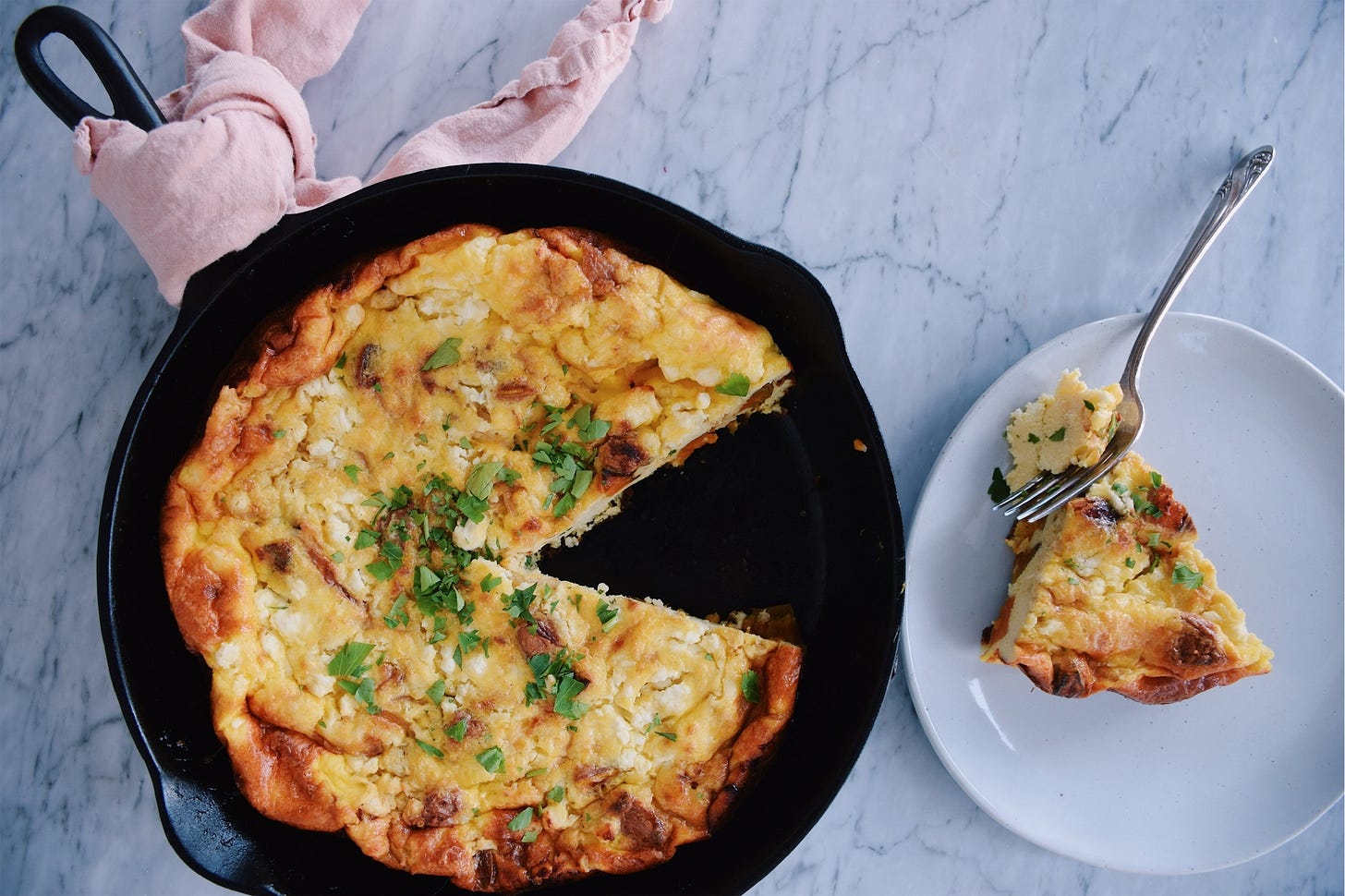Not to brag, but I'm really good at making frittatas
And now you can be too! Plus, a recipe.
Hi there,
How was your weekend? Mine was wonderful, first because of your enthusiastic response to the meal prep class series Abigail and I announced last week. If you’ve already signed up, thank you and we can’t wait to get in the kitchen with you! If not, but you’re interested, we ended up opening up a few more spots because tickets went so quickly last week (yay! again, so excited to cook with you). You can grab yours here.
The cherry on top of my weekend Sunday (see what I did there?) was that yesterday, thanks to our fully active vaccines, we had friends over inside for the first time in over a year. It was lovely, and jarring, and scrumptious, and full of laughter and good smells and interesting chats, and was all the things I’d hoped it would be and more. I made a blueberry crumble (recipe forthcoming in In Harmony: Summer) with lemon-y yogurt sauce, a simple chopped salad, and the piece de resistance: a fifteen egg frittata.
As you’ve certainly gathered in reading the less-than-humble subject of this email, it turned out perfectly. In my book, frittatas are choose-your-own-adventure fare when it comes to toppings and fillings (yesterday I did pesto, mozzarella, and sun dried tomatoes). Texture wise, though, I’m fairly picky about this baked egg dish; it should always, always have golden-brown edges that yield to a custard-y, slightly springy interior. And thanks to two very simple steps, this Sunday’s frittata and most every frittata I make these days fits this description to a T.
Here’s how:
First: use full-fat dairy in your frittata base. To create the desired custard-y texture, you need a mixture of eggs and fat. Whisk together your eggs and whatever full-fat dairy you have on hand (I’ve used whole milk, creme fraiche, yogurt, and sour cream in the past and all have worked wonderfully) in a ratio of ½ cup dairy to every dozen eggs. If you avoid dairy, I’ve had luck with the same ratio of oat milk plus a tablespoon of olive oil for every dozen eggs.
Second: start checking the frittata for doneness earlier than you think and pull it out when the center is still a bit wobbly. It’ll continue cooking as it rests out of the oven, so pulling it out 10-or-so minutes earlier than you typically would helps prevent a spongey, dry, overcooked result. I know this may seem a bit vague, and I’d never want to leave you hanging, so there are detailed instructions in the recipe below!
And here’s a recipe for Caramelized Onion, Sweet Potato, and Feta Frittata from my first e-book baby, The Beginner’s Guide to Meal Prep:
Ingredients
1 large sweet potato, diced into ¼ inch cubes
2 tablespoons olive oil
1 large yellow or sweet onion, thinly sliced
1 dozen large eggs, cracked and beaten well
½ cup full fat yogurt (or sub dairy-free milk of choice plus 1 tablespoon olive oil)
½ teaspoon salt
½ cup crumbled feta (omit for a dairy-free version)
Optional parsley for garnish
Procedure
Preheat the oven to 350°F. Add the sweet potatoes with 1 tablespoon olive oil to a parchment-lined baking sheet and roast until tender (~20 minutes).
Heat a large oven-proof skillet (I suggest a 12-14 inch cast-iron pan) with the remaining olive oil over medium heat. Add the onion to the pan and cook until deeply browned and caramelized, which should take about 20 minutes (if some parts get too dark, you can add a few tablespoons of water to the pan to distribute the color, then cook the water off).
Meanwhile, whisk the yogurt and salt into the eggs, then stir the eggs into the pan and top with feta and sweet potatoes.
Transfer the pan to the oven and bake for 20-30 minutes, or until the eggs are just set (see note). Top with optional parsley and black pepper and store for up to 5 days and enjoy.
Note: check your frittata after 20 minutes and if it seems nearly set, where just the center-most inch-or-two is wobbly when you give your pan a shake, remove it from the oven. If it’s not quite there, give it another 5 minutes, then check again, repeating this frequent checking until just the center is a bit wobbly and removing at that point. It will continue to cook and firm up as it cools and leave you with a silky smooth frittata.
I love frittatas for both meal prep and entertaining, mostly because they work really well as a make-ahead dish, inherently reducing real-time stress—they’re perfect for busy mornings and having friends over for the first time in over a year alike.
Do you have any favorite frittata filling permutations? And generally, how’s it going in your kitchen these days? Abigail and I are meeting up this week to do the bulk of the menu planning for our meal prep club and I’m excited to put pen to proverbial paper with her. I’ve always loved menu planning, and getting to do it with a pal and in anticipation of such an exciting project is a real treat. Alright, that’s it from me this week—wishing you a wonderful, well-fed week ahead.
With love and a *tip* of my chef’s hat,
Erica
Want more? I’m so flattered! You can also follow me on Instagram or check out my blog where you can find my tip-laden e-book collection.



